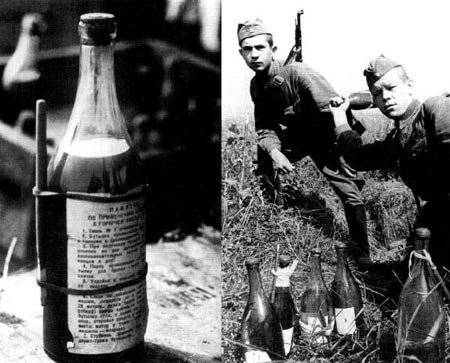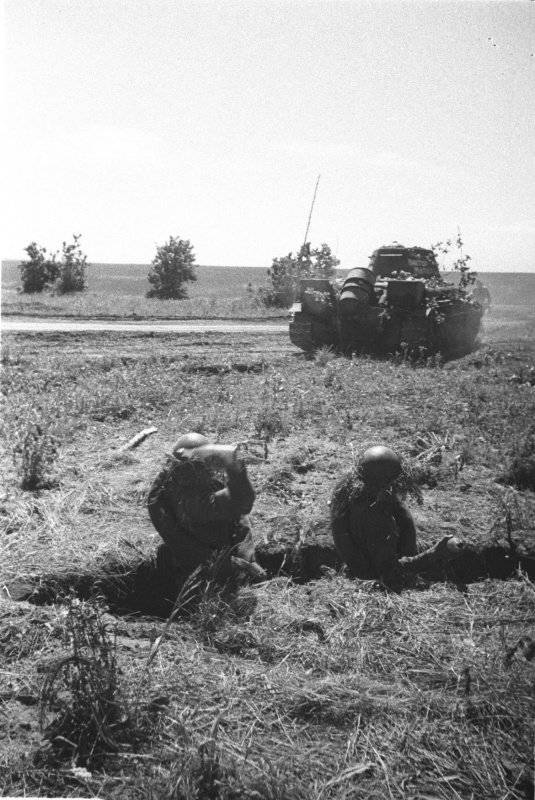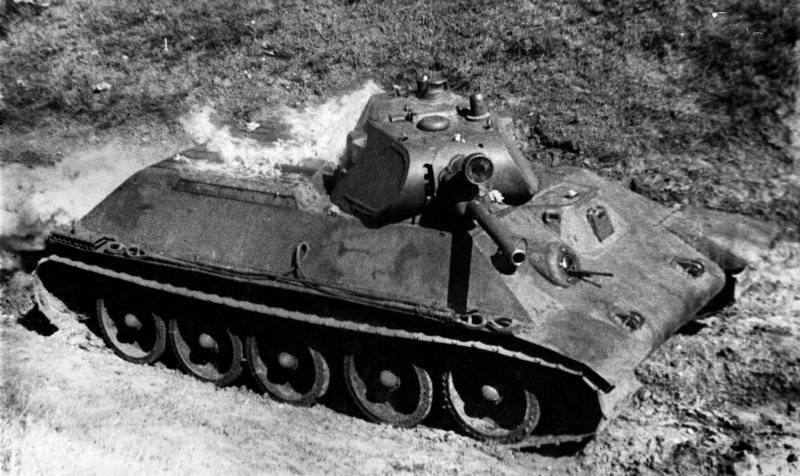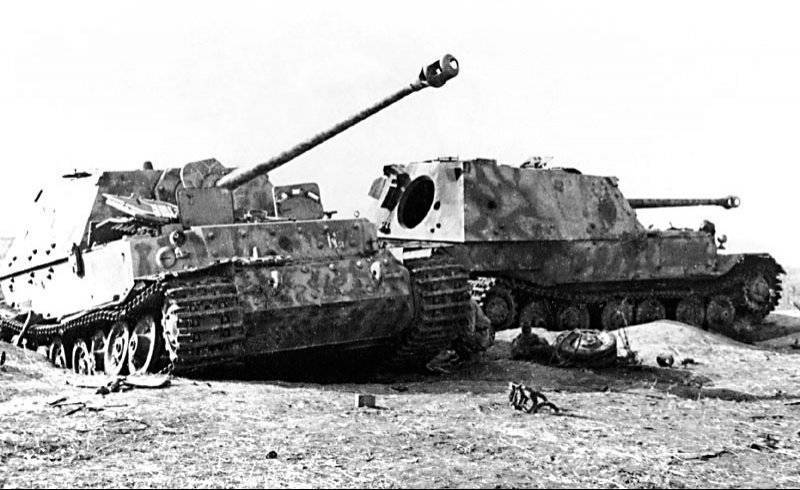Incendiary "cocktail"
 The beginning of the Great Patriotic War for the USSR was, at least, unsuccessful. For several reasons, there were problems in almost all areas of the front, production and transport. In addition, it was necessary in the shortest possible time to mobilize all opportunities to provide a worthy response to the enemy. Therefore, in the first weeks and months of the war a variety of ideas were used, including too simple at first glance. A striking example of this is the kind of incendiary weapons, which is nicknamed the Molotov cocktail. A bottle of burning liquid, for all its simplicity, was a fairly effective remedy against tanks and long-term firing points. Yes, and still this type of weapon is very popular in some circles.
The beginning of the Great Patriotic War for the USSR was, at least, unsuccessful. For several reasons, there were problems in almost all areas of the front, production and transport. In addition, it was necessary in the shortest possible time to mobilize all opportunities to provide a worthy response to the enemy. Therefore, in the first weeks and months of the war a variety of ideas were used, including too simple at first glance. A striking example of this is the kind of incendiary weapons, which is nicknamed the Molotov cocktail. A bottle of burning liquid, for all its simplicity, was a fairly effective remedy against tanks and long-term firing points. Yes, and still this type of weapon is very popular in some circles.According to the most common version, Spanish Franco players invented throwing bottles with flammable liquid into the enemy. During the Spanish Civil War, they began to fill the bottles with gasoline and make an improvised stopper made of tow or rags. Before the throw, the fighter set fire to the cork and threw a gasoline bottle into the Republican tank. Once in it, the bottle broke, gasoline poured over the surface and partially sprayed in the air. A burning rag or tow set fire to gasoline vapors and the tank engulfed the flames. Because of its fluidity, gasoline easily penetrated into the tank, where it caused burns to the crew and set fire to the engine compartment. Soon after the first use of incendiary bottles by the Francoists, this idea was adopted not only by Republicans, but also by many countries. However, there is another version about the origin of bottles with flammable liquid. According to Cuban historians, for the first time, bottles of kerosene flew at the enemy back in 1895 year. Then, during the War of Independence, the Cuban rebels took to the ring a Spanish garrison and demanded their surrender. In the event of continued resistance, the Cubans promised to use some kind of secret weapon. As is clear from the very fact of its use, the Spaniards responded negatively to the ultimatum.
In the Soviet Union, at first, they did not give due attention to the Spanish bottles of gasoline. Most likely, some distrust of frankly artisanal weapons affected. Nevertheless, the work already carried out on the topic of incendiary mixtures was continued with a new force. Investigations were carried out in two directions: the creation of special fuses for incendiary ammunition and the development of flammable flammable liquids. According to the results of the development, it was proposed to adopt a slightly modified chemical fuse of the Kibalchich system, and for the self-igniting ammunition they chose a mixture of “KS”. Chemists A. Kachugin and P. Solodovnikov were able to achieve such a ratio of phosphorus and sulfur, which, when in contact with air, instantly set fire to a flammable liquid - gasoline or kerosene. In addition to “KS”, several more flammable mixtures were created to equip incendiary ammunition of various kinds.

For a number of reasons, the start of full production of all mixtures and ammunition for them took place only after the start of the war. On July 7, 1941, the State Defense Committee issued a decree “On anti-tank incendiary grenades (bottles)”. The State Defense Committee demanded that the People's Commissariat of the Food Industry promptly launch the production of one liter bottles with incendiary mixtures. The first mentions of the name "Molotov cocktail" date from about the same time. I must say, there are several versions about the origin of the popular name for incendiary bottles. Some historians associate the name with the Finnish nickname of the Soviet rotary-scattering aviation bombs ("Molotov's bread boxes") Others nod at the signature of V.M. Molotov under the decree of the State Defense Committee. Still others believe that the name omitted the preposition “for” and the original Finnish term looked like this: “cocktail for Molotov”.
Regardless of the origin of the term, two types of bottles with flammable liquids went to the troops. At first, the liquid "KS" was poured, while the others were filled with combustible mixtures No. XXUMX and No. XXUMX. "Number" mixture was a mixture of gasoline, kerosene, ligroin and other petroleum products. They also contained the curing powder OP-1, created by chemist A.P. Ionov. In a sense, the mixture No. XXUMX and No. XXUMX can be considered analogous to napalm, which appeared a little later. The effect of “license” mixtures and “KS” liquid was slightly different: a liter of “KS” burned for about three minutes with a temperature of about a thousand degrees. The mixtures No.3 and No.2, in turn, reached only 1 ° C and burned out in about a minute. Smaller temperature and duration of combustion were compensated by the cost of production, the ability of liquids to adhere to the metal and emit dense black smoke during combustion. As mentioned above, the mixture of "KS" spontaneously ignited on contact with air. “Numbered” liquids did not have such an opportunity, so we had to start production of ampoules-igniters. From two to four small glass ampoules with liquid “KS” were attached to the bottle with the mixture No. 3 or No. XXUMX. When it hit the target, the bottle broke, the mixture poured out, and the destruction of the ampoule-igniter caused the “KS” to ignite and, as a result, to ignite all the leaked fuel. An alternative to bottles with “KS” and mixtures №1 and №3 were bottles with simple gasoline. They were also equipped with igniters for ignition. By the end of 800, large-scale production of BGS ognemesis developed by chemist K.M. Saldadze It was to some extent analogous to the “KS” and also had the ability to ignite when in contact with air.

In the autumn of 41, the first batches of new chemical igniters went to the troops, which could be safely used with all kinds of non-inflammable liquids. Instead of KS liquid, sulfuric acid, bertolet salt and powdered sugar were placed in a vial. When the ampoule was damaged, the mixture ignited and ignited the fuel vapor surrounding it. Compared to the fuse based on the “KS”, this fuse was slightly cheaper, and in addition it could reduce the consumption of a self-igniting liquid. However, a completely new vial did not force out the old one, and they were made together until the end of the war. Another alternative variant of the fuse of the gunsmith G. Korobov was based on a blank pistol cartridge 7,62x25 mm. A simple mechanism, resembling a grenade detonator, was mounted on a bottle and at the right moment created a flash, which ignited a flammable liquid.
12 August 1941, People's Commissar of Defense I.V. Stalin put his signature under the "Instruction of the application of incendiary bottles." It not only described the main types of incendiary ammunition and features of liquids, but also required the creation of separate groups of tank fighter soldiers with anti-tank grenades and incendiary bottles at the regiments and divisions. By the middle of autumn, the incendiary bottles will no longer be the “property” of only the extermination groups, and the entire personnel of the Red Army will train them. Recommendations on the use of bottles with fire mixtures were simple: let the victim tank for a short distance (less than 30 meters) and throw the bottle under the turret chase or on the roof of the engine compartment. The tanks of that time did not have any means of sealing the hull, so theoretically any contact with a combustible liquid on the external surface of the tank could be fatal to it. Nevertheless, in order to reduce the consumption of ammunition and reduce the risk for personnel, it was recommended to throw bottles at the vulnerable points of enemy armored vehicles. In addition, to reduce the likelihood of injury or death of a fighter fighter, it was recommended to throw bottles out of the trench. This, of course, was much safer than going out into the open country, but still many soldiers died from an accidental bullet or splinter that got into the bottle. In this case, the fighter instantly turned into a living torch and the fighting qualities of combustible mixtures did not give him a chance to survive. Yes, and in other aspects, the combat work of a tank fighter soldier was no easier. Although, it should be noted, it was much easier for the Red Army soldiers to fight with tanks with the help of incendiary means than for German soldiers. The fact is that in Germany there were no analogues of “Molotov cocktails” and the Wehrmacht’s fighters, in the absence of other possibilities, were asked to destroy the tank by hand pouring it with gasoline and setting it on fire manually. It is clear that the number of Soviet armored vehicles destroyed in this way tends to zero. Meanwhile, Soviet soldiers were developing new ways to use incendiary bottles. For example, it was possible to throw a bunch of grenades under the caterpillar of the tank, thereby immobilize it and complete the job by throwing the bottle on the engine compartment. Naturally, this required good accuracy and remarkable bravery. Anyway, regardless of the method used, an experienced tank fighter soldier spent no more than five bottles on one armored vehicle. But the losses were considerable. Used incendiary bottles and partisans. However, difficulties with the supply did not allow them to widely use this type of weapon. Most of the bottles were spent by partisans during sabotage and ambush organizations. Fundamentally, the use of “Molotov cocktails” by partisans differed little from the use of combatant units.

Soldier savvy of the Red Army generated not only new ways to throw the bottle. In the autumn of 41, near Moscow, Molotov cocktails were first used as fire bombs. Soviet sappers began to "fill" the mines with Molotov cocktails. So, near the anti-personnel mine lay one bottle, and the anti-tank could be "attached" to twenty. With the explosion of a mine, the enemy was defeated by a shock wave, fragments and a flammable liquid flying around. In addition, the explosion of such a combined mine also had a psychological effect - hardly anyone could remain indifferent to a fiery column up to ten meters high. With the explosion of an anti-tank mine with two dozen bottles, the burning mixture was scattered over an area of the order of 300 sq.m.
By the end of the summer, 41-th was invented another alternative way to use bottles with "KS" or other mixtures. This time he touched throwing. The gunsmiths created a special rifle mortar, which, with the help of a blank cartridge and a wooden wad-piston, sent a half-liter bottle to a distance of about 80 meters. During the battle for Moscow, the command tried to equip each rifle squad with one or two such mortars. Unfortunately, the widespread use of new projectile was prevented by the fact that not all bottles were suitable for shooting, but only the strongest ones. Otherwise, not glass ammunition, but fragments and a jet of fire, flew out of the mortar.
With the course of the Great Patriotic War and the gradual change of the situation at the front, with the gradual transition of the initiative to the Soviet Union, the relevance of the “handicraft” incendiary weapon in the form of a bottle with fire mixture began to decrease. In the long run, defense enterprises were able to start mass production of more serious and safer hand ammunition. Therefore, starting with 1943, the release of Molotov cocktails began to decline until it reached its minimum. Until the end of the war, the production of incendiary bottles continued in much smaller quantities than, for example, in the 1942 year. After the victory, the production of such incendiary ammunition was discontinued and no longer resumed. Over the years of the Great Patriotic War, according to the available data, about 2500 armored vehicles, 1200 long-term fire points, 2500 dugouts and other fortifications, about 800 vehicles, 65 warehouses and several thousand soldiers and officers were destroyed with fire mixtures.
Soon after the end of the Second World War, their own versions of the “Molotov cocktails” began to be removed from the arsenal as well. The last “strike” on the use of incendiary bottles as an anti-tank weapon was made by anti-tank rocket launchers, which have much greater reliability and probability of destruction by enemy armored vehicles. Bottles with flammable liquid simply could not withstand competition with them, as a result of which they fell out of use even in the armies of third world countries.
Based on:
Ardashev A.N. Flame-incendiary weapons. - M .: Astrel, 2001
http://i-r.ru/
http://www.jaegerplatoon.net/
Information